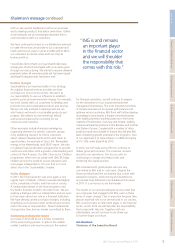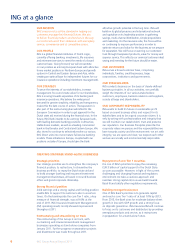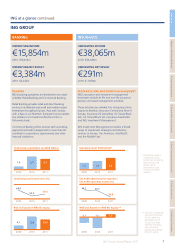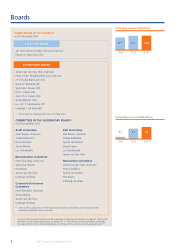ING Direct 2011 Annual Report Download - page 16
Download and view the complete annual report
Please find page 16 of the 2011 ING Direct annual report below. You can navigate through the pages in the report by either clicking on the pages listed below, or by using the keyword search tool below to find specific information within the annual report.
DUTCH LEGISLATIVE MEASURES
In anticipation of EU regulation the Dutch authorities have already
announced a number of related measures.
Dutch intervention law
A new draft legislative proposal on crisis management would, if
enacted, grant new powers to the DNB and the Minister of Finance
to intervene in situations where an institution faces financial
difficulties or where there is a serious and immediate risk to the
stability of the financial system caused by an institution in difficulty.
Bank levy
On 1 July 2011, the Dutch Ministry of Finance announced a
temporary reduction of the real estate transfer tax from 6%
to2%. In the announcement several ways of funding the
reduction were identified, the introduction of a bank tax being
one of them. The levy may enter into force in 2012. Dutch and
non-Dutch entities with banking activities in the Netherlands will
be included in its scope. The taxable base of the levy is the liability
side of the (global consolidated) balance sheet with an exemption
for equity, for deposits that are covered by a deposit guarantee
scheme and for certain liabilities that relate to insurance business.
Therate of short-term funding (less than one year) will be twice
the rate of long-term funding (more than one year). Currently, total
yearly tax proceeds of EUR 300 million are expected. We believe
the timing and motivation for such a tax to be less opportune
given the economic climate and conditions in financial markets.
Deposit Guarantee Scheme
In August 2011, the Ministry of Finance and the DNB published their
proposal to establish an ex-ante funded Deposit Guarantee Scheme
(DGS) in the Netherlands. As was announced at an earlier stage by
the Dutch finance minister, the target level of the fund will be 1%
of total guaranteed deposits in the Netherlands. This equals about
EUR 4 billion, to be built up, in principle, within 15 years. The main
element of the proposal is that for each bank the individual target
amount is defined as 1% of its guaranteed deposit base. To reach
this individual target amount, every bank pays a base premium of
0.025% per quarter of the guaranteed deposits. Additionally, a risk
add-on of 0%, 25%, 50% or 100% of the base premium has to be
paid by every bank, depending on its risk weighting.
Executive compensation legislation
Currently a legislative proposal is under discussion in the Dutch
Parliament relating to variable remuneration at financial institutions
that have received state support for reasons of financial stability,
such as ING. If and when entered into force, the legislation prevents
these financial institutions from granting variable remuneration (in
cash or otherwise) to their Executive Board members. In addition,
the legislation contains certain restrictions with respect to the
possibility of increasing the fixed salary of Executive Board members.
SOLVENCY II
The most important regulatory issue for the insurance industry in
Europe is the continued development by the European Union of the
Solvency II capital adequacy framework. Solvency II is intended to
be based on economic, risk-based and market-consistent principles
whereby capital requirements across Europe are directly dependent
on an insurer’s assets and liabilities.
Such a framework should enable insurance companies to play
theirfundamental role in society for consumers, corporates and
theeconomy. Insurance companies take the risks off the shoulders
Third, as many new rules are still in development, we have some
concerns about the actual implementation. There is a clear tendency
for national authorities to have different and fragmented approaches
to implementation, which is reflected both in the speed of
introduction of new measures and the content of measures. This
applies to the new capital and liquidity standards in Basel III/CRD IV,
where regulators in some countries are implementing ahead of the
time frames set by the Basel Committee or are setting additional
requirements at the national level. It also holds for crisis management
regulation (insolvency laws). While an EU framework is under
discussion, several countries are considering or have already
announced they will adopt their own specific measures. This is
leading to a lot of uncertainty, not only for financial companies,
butalso for equity investors and bond investors.
EBA STRESS TEST AND CAPITAL EXERCISE
In July 2011, the European Banking Authority (EBA) published the
results of the second round of stress tests. The first round was
conducted in 2010 by the EBA’s predecessor, the Committee of
European Banking Supervisors (CEBS). The tests assessed the
resilience of European banks to adverse market developments and
tested their solvency levels under hypothetical stress events. The
test in July 2011 again confirmed the strong capital position of ING
Bank which makes us better equipped to absorb adverse shocks.
In addition to the EU-wide stress test in summer 2011, the EBA
performed an additional capital exercise in December 2011. The
objective of the capital exercise was to create an exceptional and
temporary capital buffer to address current market concerns over
sovereign risk and other residual credit risks related to the current
difficult market environment. Following the completion of the
capital exercise, which the EBA conducted in close cooperation
with the Dutch central bank (De Nederlandsche Bank, DNB), it
wasdetermined that ING Bank met the 9% core Tier 1 ratio.
ADDITIONAL MEASURES FOR SYSTEMICALLY IMPORTANT
FINANCIAL INSTITUTIONS
In 2011 the Basel Committee issued a consultative document on
Global Systemically Important Banks (G-SIBs) as part of a broader
package of policy measures to address Systemically Important
Financial Institutions (SIFIs). The Financial Stability Board (FSB)
reviewed and approved the package and submitted it for approval
to the G20 in November 2011. As ING has been earmarked as a
Global Systemically Important Financial Institution (G-SIFI), we could
be subject to an additional capital surcharge. In November 2011,
theDutch central bank (DNB) and the Dutch government
announced additional capital buffers for domestic systemically
relevant banks. Depending on the degree of systemic relevance, the
additional requirement amounts to 1 to 3 percent of risk-weighted
assets (RWA) and this includes the internationally agreed (FSB)
buffer. The aim is to introduce the buffer gradually from 2016 to
2019, thereby allowing banks to generate capital from retained
earnings.
Another important element of internationally agreed policy measures
is the obligation for banks to set up recovery and resolution plans.
Inthe recovery plans, which are drafted in close coordination with
the main supervisor, banks have to draw up plans for the restoration
of their financial situation in the event of a significant deterioration.
Animportant element of these plans is risk mitigating measures
withrespect to capital and liquidity. In addition, clear governance
principles have to be established. ING is in the process of finalising
itsrecovery plan which it currently plans to update annually.
14 ING Group Annual Report 2011
Financial and regulatory environment continued
























